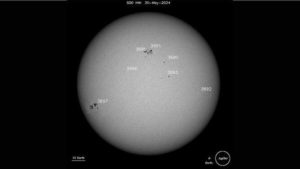Sun’s active regions make ‘rare’ return with more strong geomagnetic storms possible in June
This month, the Sun produced the most intense geomagnetic storms in 20 years and Northern Lights as far south as the southern U.S. Now, active Sun regions are facing Earth, putting Earth in the line of fire once again.

Sunspot regions 3663 and 3664, which caused the G5-level geomagnetic storms in mid-May, are back but with new names as they emerge from the other side of the Sun. Old region 3663 is now 3691, and old region 3664 is now 3697. On the other side of the Sun, the areas were facing toward Mars, sending space weather toward the Red Planet.
NOAA’s Space Weather Prediction Center has been busy tracking activity in these regions, including a long-duration strong flare and associated coronal mass ejection prompting a Geomagnetic Storm Watch.
SWPC Service Coordinator Shawn Dahl said these two regions are unusual because they survived the Sun’s full rotation and continue to produce strong flares.
“Most sunspot groups don’t last very long,” Dahl said. “We get small ones that show up, and then they go away because the magnetic field just isn’t that strong or intensifies rather quickly. The larger groups, they tend to last well as the Sun rotates. We see them, but they don’t survive that rotation.”
Dahl said it’s not surprising the groups survived, but it is unusual they are still magnetically complex enough to produce X-class flares or strong radio blackouts.
“The fact that it’s still producing activity, at least the southern one, that is very rare, that it’s done that,” Dahl said. “I’d say we’re still in store for some great chances here for seeing the Northern Lights further south than usual.”
What kind of solar storms can we expect this summer
Over the next days, these two areas will be closer to the middle of the Sun, directly facing Earth. If a strong flare produces a coronal mass ejection, this is when Earth could see geomagnetic storm impacts like the intense Northern Lights experienced about May 10.
The G5-level Geomagnetic Storm Watch, the highest on NOAA’s space weather scale, issued by the SWPC in May was the first since 2005. Dahl said it’s too early to tell if we’ll be seeing another G5 solar storm soon, but with the solar maximum of our star’s 11-year cycle approaching, space weather will be very active into next year.
“We’re just kind of getting near solar Max, and we’re not even there yet, necessarily. So yeah, this cycle is going to prove to be interesting,” Dahl said. “We could certainly see the potential for more G4-level storms. I can’t say G5, though, because it’s so rare, right? We don’t have any new measure of confidence of saying that we may have another G5 to come. But it’s certainly not outside the realm of possibility.”
Those hoping for another good show of Northern lights can follow the SWPC website for updates.
What causes far-reaching Northern Lights?
Dahl explains that coronal mass ejections that cause the Northern Lights need favorable conditions for Earth to see aurora lights far from Earth’s poles.
“If it’s the same orientation as Earth, Earth’s magnetic field is pointing north, pointed up, and the CME arrives in the same direction,” Dahl said. “You get an initial punch, there is some action, but then it’ll settle down pretty quickly.”
In May, the CME arrived and stayed connected to Earth’s magnetic field for more than 24 hours.
After the initial CME is seen blasting away from the Sun, space weather forecasters see it, but then they have to wait for the solar wind to reach a NASA satellite 1 million miles from Earth to issue warnings or geomagnetic storm watches.
Historic geomagnetic storm was a success story for space weather forecasting
Most people on Earth know solar storms can produce a beautiful Aurora Borealis, but they can also impact important systems we use every day, including GPS, the power grid and communications.
As SWPC service coordinator, Dahl constantly reviews how space weather will impact the airline industry, the power grid or the astronauts on the International Space Station. The SWPC is still trying to understand how widespread impacts from May’s G5 geomagnetic storm were.
Dahl said satellite operators, like SpaceX’s Starlink ones, were very busy during the event, maintaining proper orbital levels.
The geomagnetic storm interrupted crop planting in the U.S. and Canada because their tractors require precision GPS.
“They’re supposed to be accurate within a centimeter. They were off by ten feet. Plus, it was taking them in circles, doing weird movements,” Dahl said. “They had to suspend operations.”
Overall, the public did not see direct impacts from the storm, and Dahl said that was how it should have been.
“This was the most successfully mitigated extreme space weather storm in history,” Dahl said. “This has been a decade or more worth of work to get to this point where everybody’s properly informed and ready and has plans in place.”
The U.S. wasn’t as prepared for the 2003 Halloween geomagnetic storms, and space weather forecasting was still a growing field. The past three White House administrations have implemented policies and legislation to be space-weather prepared. Had that not occurred, Dahl said the May geomagnetic storm could have been a different story.
yogaesoteric
June 5, 2024
